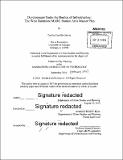| dc.contributor.advisor | Brent D. Ryan. | en_US |
| dc.contributor.author | Gauvin, Tamika Camille | en_US |
| dc.contributor.other | Massachusetts Institute of Technology. Department of Urban Studies and Planning. | en_US |
| dc.coverage.spatial | n-us-md | en_US |
| dc.date.accessioned | 2016-01-15T21:11:37Z | |
| dc.date.available | 2016-01-15T21:11:37Z | |
| dc.date.copyright | 2010 | en_US |
| dc.date.issued | 2014 | en_US |
| dc.identifier.uri | http://hdl.handle.net/1721.1/100892 | |
| dc.description | Thesis: M.C.P., Massachusetts Institute of Technology, Department of Urban Studies and Planning, February 2014. | en_US |
| dc.description | "September 2010." Page 120 blank. Cataloged from PDF version of thesis. | en_US |
| dc.description | Includes bibliographical references (pages 116-118). | en_US |
| dc.description.abstract | razed and thousands of residents displaced to make way for what would have been 1-170, a highway that would have connected to 1-70 in Baltimore County to the Baltimore City Central Business District. After years of intense community opposition, the Highway was halted after a segment of the Highway ha d already been built. Thirty years later, West Baltimore is the backdrop to another major public project. The Maryland Transit Administration (MTA) will redevelop the West Baltimore MARC station as a Transit-Oriented Development (TOD) via the West Baltimore MARC Station Area Master Plan for Transit- Centered Community Development (The Plan). This Plan could redirect investment into the severely disinvested areas in West Baltimore. This research examines the intended results of the Plan to understand the realistic development opportunities for the West Baltimore MARC Station Area and the role that urban design and development could play in supporting or hampering the project's success potential. I make suggestions that would improve the Plan's urban design and development approach to achieve better outcomes for community transformation. I recommend improved connections to existing community assets, minimal use of parking structures on prime Station Area blocks, using targeted economic development initiatives to create jobs for West Baltimore residents, a formal study for development scenarios for the Highway, and the creation of a project oversight group. | en_US |
| dc.description.statementofresponsibility | by Tamika Camille Gauvin. | en_US |
| dc.format.extent | 120 pages | en_US |
| dc.language.iso | eng | en_US |
| dc.publisher | Massachusetts Institute of Technology | en_US |
| dc.rights | M.I.T. theses are protected by copyright. They may be viewed from this source for any purpose, but reproduction or distribution in any format is prohibited without written permission. See provided URL for inquiries about permission. | en_US |
| dc.rights.uri | http://dspace.mit.edu/handle/1721.1/7582 | en_US |
| dc.subject | Urban Studies and Planning. | en_US |
| dc.title | Development under the burden of infrastructure : The West Baltimore MARC Station area master plan | en_US |
| dc.title.alternative | West Baltimore MARC Station area master plan | en_US |
| dc.type | Thesis | en_US |
| dc.description.degree | M.C.P. | en_US |
| dc.contributor.department | Massachusetts Institute of Technology. Department of Urban Studies and Planning | |
| dc.identifier.oclc | 933612430 | en_US |
